Marketing Strategy and Plan: McDonald's Case Study Analysis
VerifiedAdded on 2022/11/29
|5
|1110
|152
Report
AI Summary
This report provides a comprehensive analysis of McDonald's marketing strategy and plan. It begins with a historical overview of McDonald's marketing campaigns, including the evolution of their slogans and advertising mediums, such as television, radio, and social media. The report examines the transfer of specific campaigns overseas and how McDonald's adapted its strategies for international markets, using examples from Australia and Germany. It explores the company's entry into China, highlighting the research conducted and the challenges faced. The report delves into McDonald's current policies and strategies, including its cost leadership approach and operational strategies focused on customer satisfaction. The business model is also discussed, emphasizing the role of franchisees, suppliers, and employees. The report references various academic sources to support its findings, providing a detailed understanding of McDonald's global marketing success.
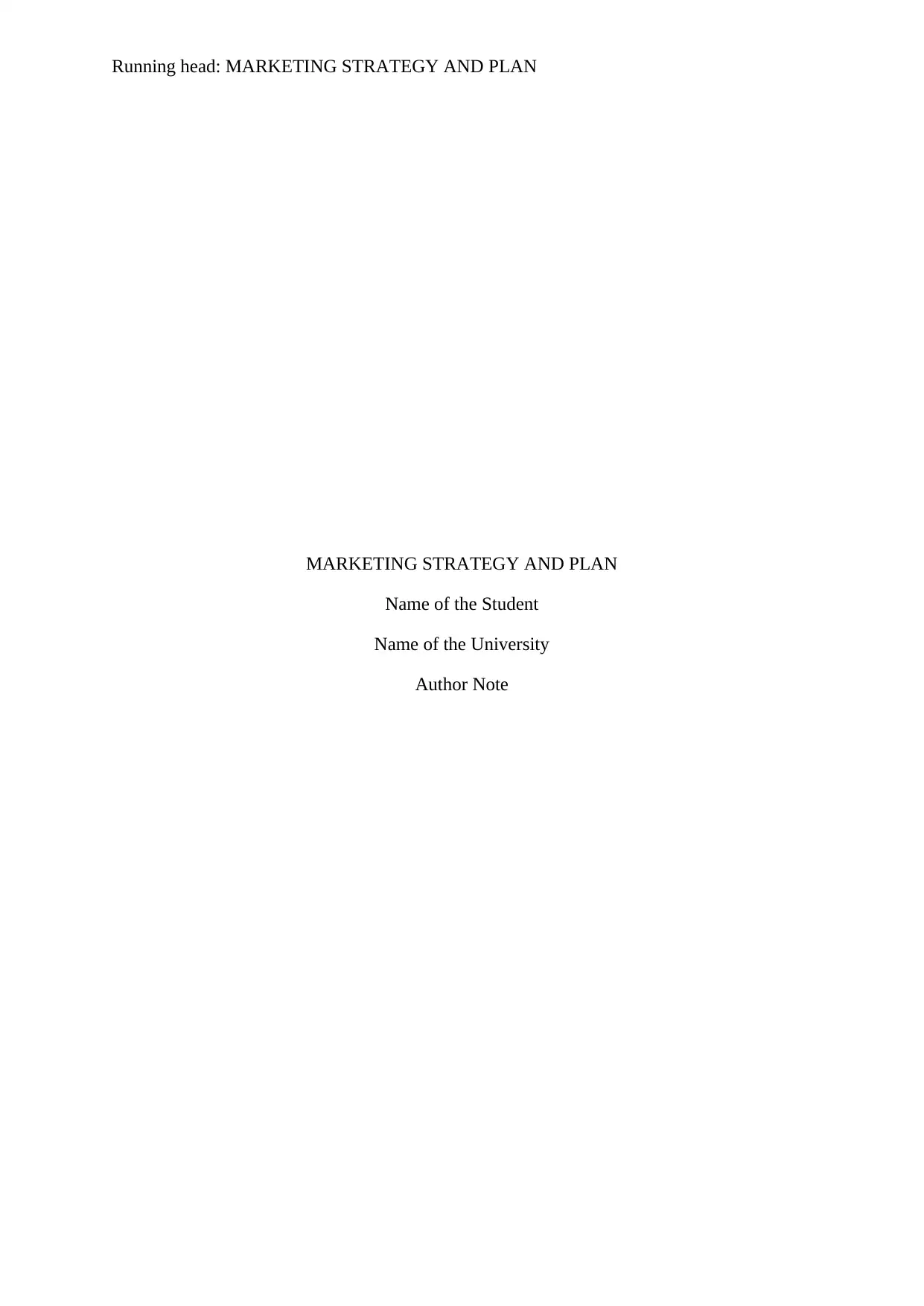
Running head: MARKETING STRATEGY AND PLAN
MARKETING STRATEGY AND PLAN
Name of the Student
Name of the University
Author Note
MARKETING STRATEGY AND PLAN
Name of the Student
Name of the University
Author Note
Paraphrase This Document
Need a fresh take? Get an instant paraphrase of this document with our AI Paraphraser
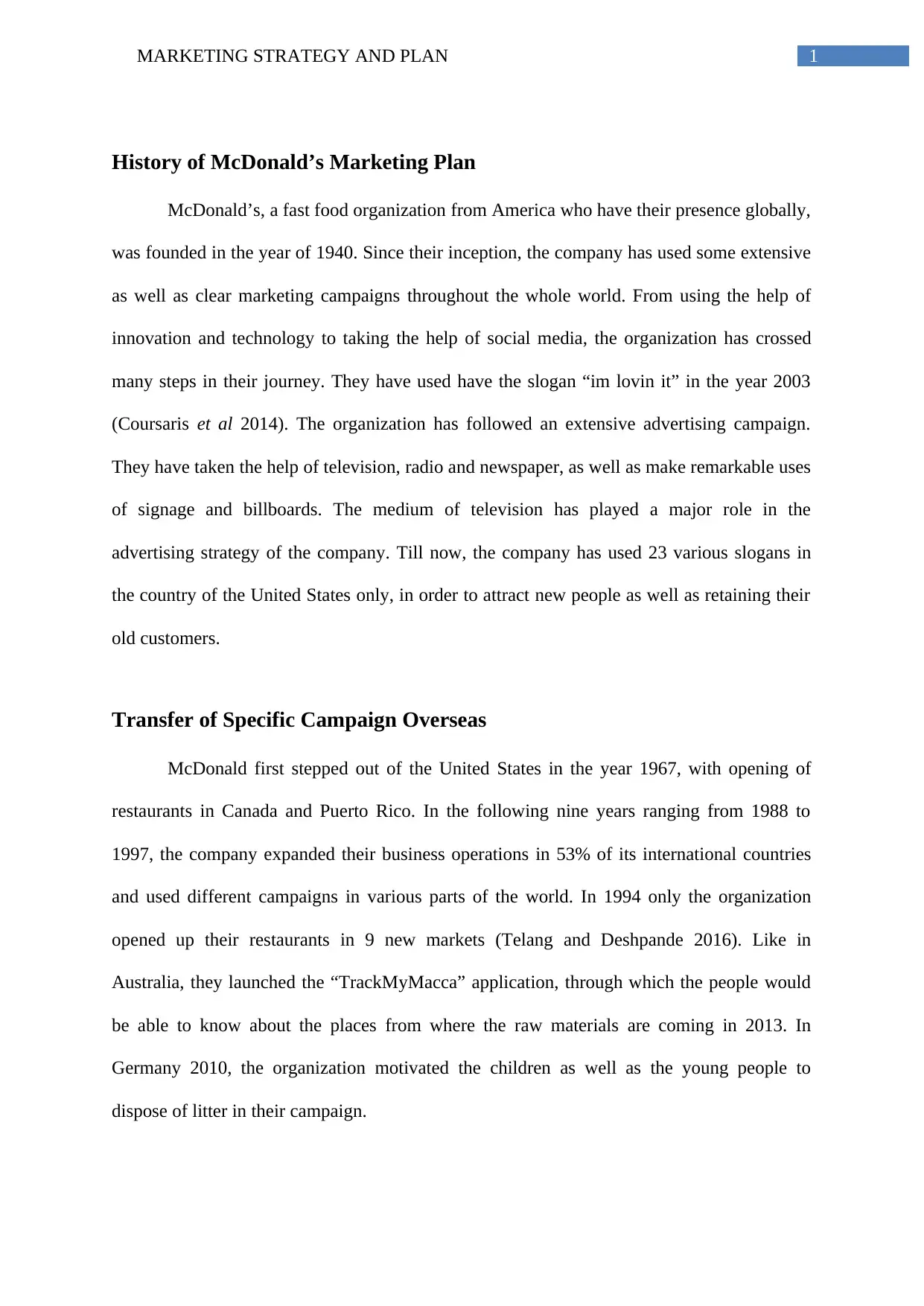
1MARKETING STRATEGY AND PLAN
History of McDonald’s Marketing Plan
McDonald’s, a fast food organization from America who have their presence globally,
was founded in the year of 1940. Since their inception, the company has used some extensive
as well as clear marketing campaigns throughout the whole world. From using the help of
innovation and technology to taking the help of social media, the organization has crossed
many steps in their journey. They have used have the slogan “im lovin it” in the year 2003
(Coursaris et al 2014). The organization has followed an extensive advertising campaign.
They have taken the help of television, radio and newspaper, as well as make remarkable uses
of signage and billboards. The medium of television has played a major role in the
advertising strategy of the company. Till now, the company has used 23 various slogans in
the country of the United States only, in order to attract new people as well as retaining their
old customers.
Transfer of Specific Campaign Overseas
McDonald first stepped out of the United States in the year 1967, with opening of
restaurants in Canada and Puerto Rico. In the following nine years ranging from 1988 to
1997, the company expanded their business operations in 53% of its international countries
and used different campaigns in various parts of the world. In 1994 only the organization
opened up their restaurants in 9 new markets (Telang and Deshpande 2016). Like in
Australia, they launched the “TrackMyMacca” application, through which the people would
be able to know about the places from where the raw materials are coming in 2013. In
Germany 2010, the organization motivated the children as well as the young people to
dispose of litter in their campaign.
History of McDonald’s Marketing Plan
McDonald’s, a fast food organization from America who have their presence globally,
was founded in the year of 1940. Since their inception, the company has used some extensive
as well as clear marketing campaigns throughout the whole world. From using the help of
innovation and technology to taking the help of social media, the organization has crossed
many steps in their journey. They have used have the slogan “im lovin it” in the year 2003
(Coursaris et al 2014). The organization has followed an extensive advertising campaign.
They have taken the help of television, radio and newspaper, as well as make remarkable uses
of signage and billboards. The medium of television has played a major role in the
advertising strategy of the company. Till now, the company has used 23 various slogans in
the country of the United States only, in order to attract new people as well as retaining their
old customers.
Transfer of Specific Campaign Overseas
McDonald first stepped out of the United States in the year 1967, with opening of
restaurants in Canada and Puerto Rico. In the following nine years ranging from 1988 to
1997, the company expanded their business operations in 53% of its international countries
and used different campaigns in various parts of the world. In 1994 only the organization
opened up their restaurants in 9 new markets (Telang and Deshpande 2016). Like in
Australia, they launched the “TrackMyMacca” application, through which the people would
be able to know about the places from where the raw materials are coming in 2013. In
Germany 2010, the organization motivated the children as well as the young people to
dispose of litter in their campaign.
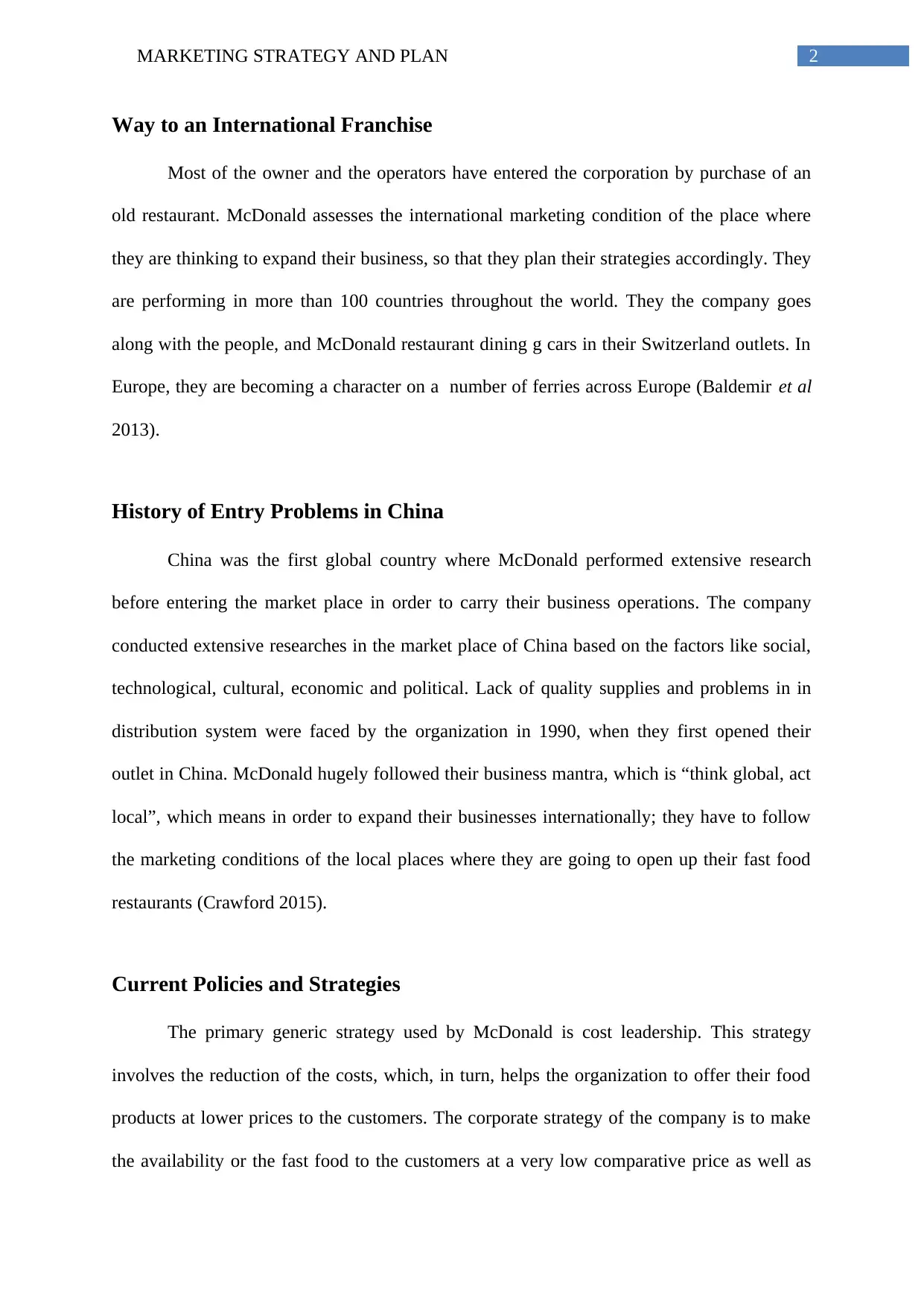
2MARKETING STRATEGY AND PLAN
Way to an International Franchise
Most of the owner and the operators have entered the corporation by purchase of an
old restaurant. McDonald assesses the international marketing condition of the place where
they are thinking to expand their business, so that they plan their strategies accordingly. They
are performing in more than 100 countries throughout the world. They the company goes
along with the people, and McDonald restaurant dining g cars in their Switzerland outlets. In
Europe, they are becoming a character on a number of ferries across Europe (Baldemir et al
2013).
History of Entry Problems in China
China was the first global country where McDonald performed extensive research
before entering the market place in order to carry their business operations. The company
conducted extensive researches in the market place of China based on the factors like social,
technological, cultural, economic and political. Lack of quality supplies and problems in in
distribution system were faced by the organization in 1990, when they first opened their
outlet in China. McDonald hugely followed their business mantra, which is “think global, act
local”, which means in order to expand their businesses internationally; they have to follow
the marketing conditions of the local places where they are going to open up their fast food
restaurants (Crawford 2015).
Current Policies and Strategies
The primary generic strategy used by McDonald is cost leadership. This strategy
involves the reduction of the costs, which, in turn, helps the organization to offer their food
products at lower prices to the customers. The corporate strategy of the company is to make
the availability or the fast food to the customers at a very low comparative price as well as
Way to an International Franchise
Most of the owner and the operators have entered the corporation by purchase of an
old restaurant. McDonald assesses the international marketing condition of the place where
they are thinking to expand their business, so that they plan their strategies accordingly. They
are performing in more than 100 countries throughout the world. They the company goes
along with the people, and McDonald restaurant dining g cars in their Switzerland outlets. In
Europe, they are becoming a character on a number of ferries across Europe (Baldemir et al
2013).
History of Entry Problems in China
China was the first global country where McDonald performed extensive research
before entering the market place in order to carry their business operations. The company
conducted extensive researches in the market place of China based on the factors like social,
technological, cultural, economic and political. Lack of quality supplies and problems in in
distribution system were faced by the organization in 1990, when they first opened their
outlet in China. McDonald hugely followed their business mantra, which is “think global, act
local”, which means in order to expand their businesses internationally; they have to follow
the marketing conditions of the local places where they are going to open up their fast food
restaurants (Crawford 2015).
Current Policies and Strategies
The primary generic strategy used by McDonald is cost leadership. This strategy
involves the reduction of the costs, which, in turn, helps the organization to offer their food
products at lower prices to the customers. The corporate strategy of the company is to make
the availability or the fast food to the customers at a very low comparative price as well as
⊘ This is a preview!⊘
Do you want full access?
Subscribe today to unlock all pages.

Trusted by 1+ million students worldwide
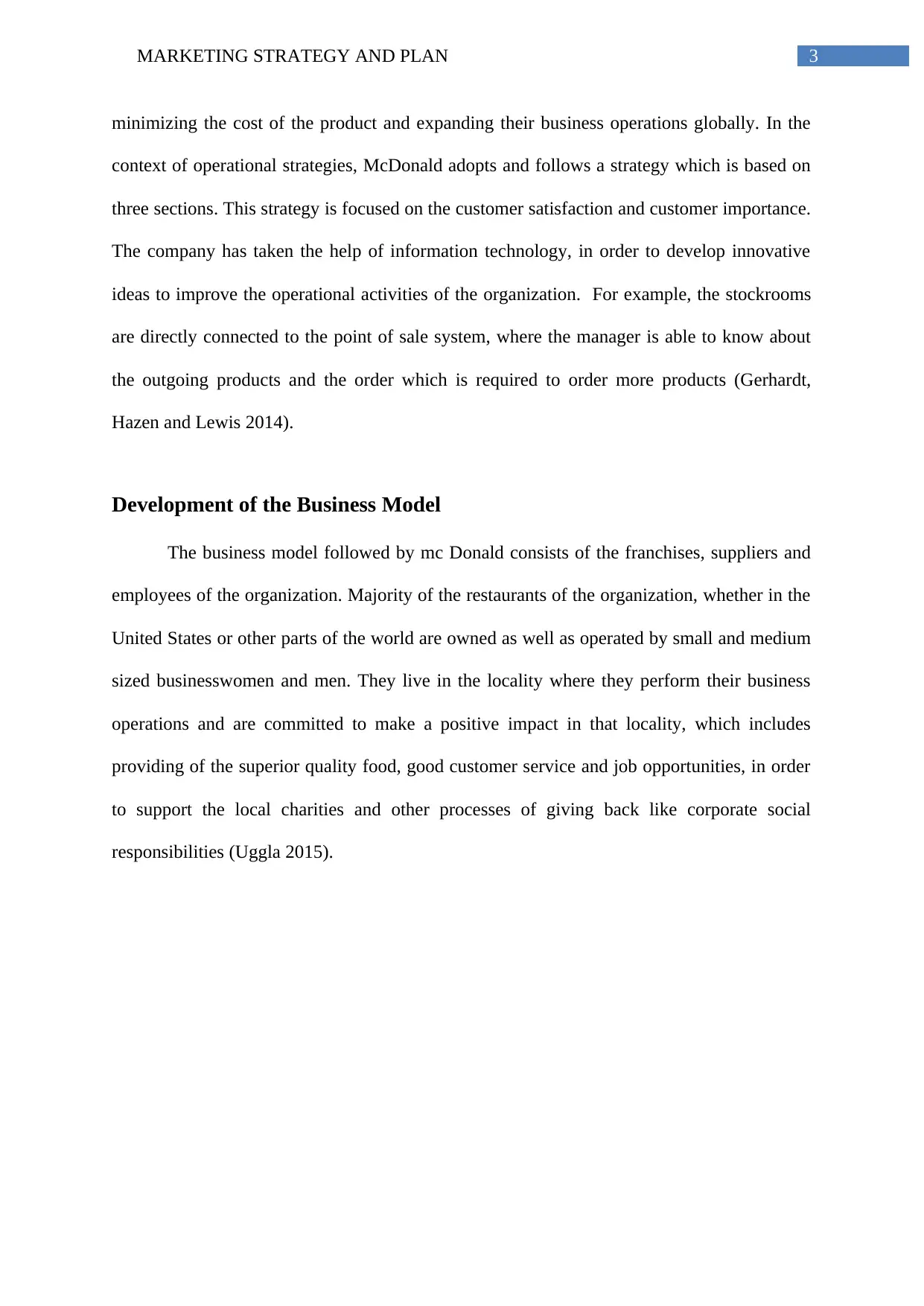
3MARKETING STRATEGY AND PLAN
minimizing the cost of the product and expanding their business operations globally. In the
context of operational strategies, McDonald adopts and follows a strategy which is based on
three sections. This strategy is focused on the customer satisfaction and customer importance.
The company has taken the help of information technology, in order to develop innovative
ideas to improve the operational activities of the organization. For example, the stockrooms
are directly connected to the point of sale system, where the manager is able to know about
the outgoing products and the order which is required to order more products (Gerhardt,
Hazen and Lewis 2014).
Development of the Business Model
The business model followed by mc Donald consists of the franchises, suppliers and
employees of the organization. Majority of the restaurants of the organization, whether in the
United States or other parts of the world are owned as well as operated by small and medium
sized businesswomen and men. They live in the locality where they perform their business
operations and are committed to make a positive impact in that locality, which includes
providing of the superior quality food, good customer service and job opportunities, in order
to support the local charities and other processes of giving back like corporate social
responsibilities (Uggla 2015).
minimizing the cost of the product and expanding their business operations globally. In the
context of operational strategies, McDonald adopts and follows a strategy which is based on
three sections. This strategy is focused on the customer satisfaction and customer importance.
The company has taken the help of information technology, in order to develop innovative
ideas to improve the operational activities of the organization. For example, the stockrooms
are directly connected to the point of sale system, where the manager is able to know about
the outgoing products and the order which is required to order more products (Gerhardt,
Hazen and Lewis 2014).
Development of the Business Model
The business model followed by mc Donald consists of the franchises, suppliers and
employees of the organization. Majority of the restaurants of the organization, whether in the
United States or other parts of the world are owned as well as operated by small and medium
sized businesswomen and men. They live in the locality where they perform their business
operations and are committed to make a positive impact in that locality, which includes
providing of the superior quality food, good customer service and job opportunities, in order
to support the local charities and other processes of giving back like corporate social
responsibilities (Uggla 2015).
Paraphrase This Document
Need a fresh take? Get an instant paraphrase of this document with our AI Paraphraser
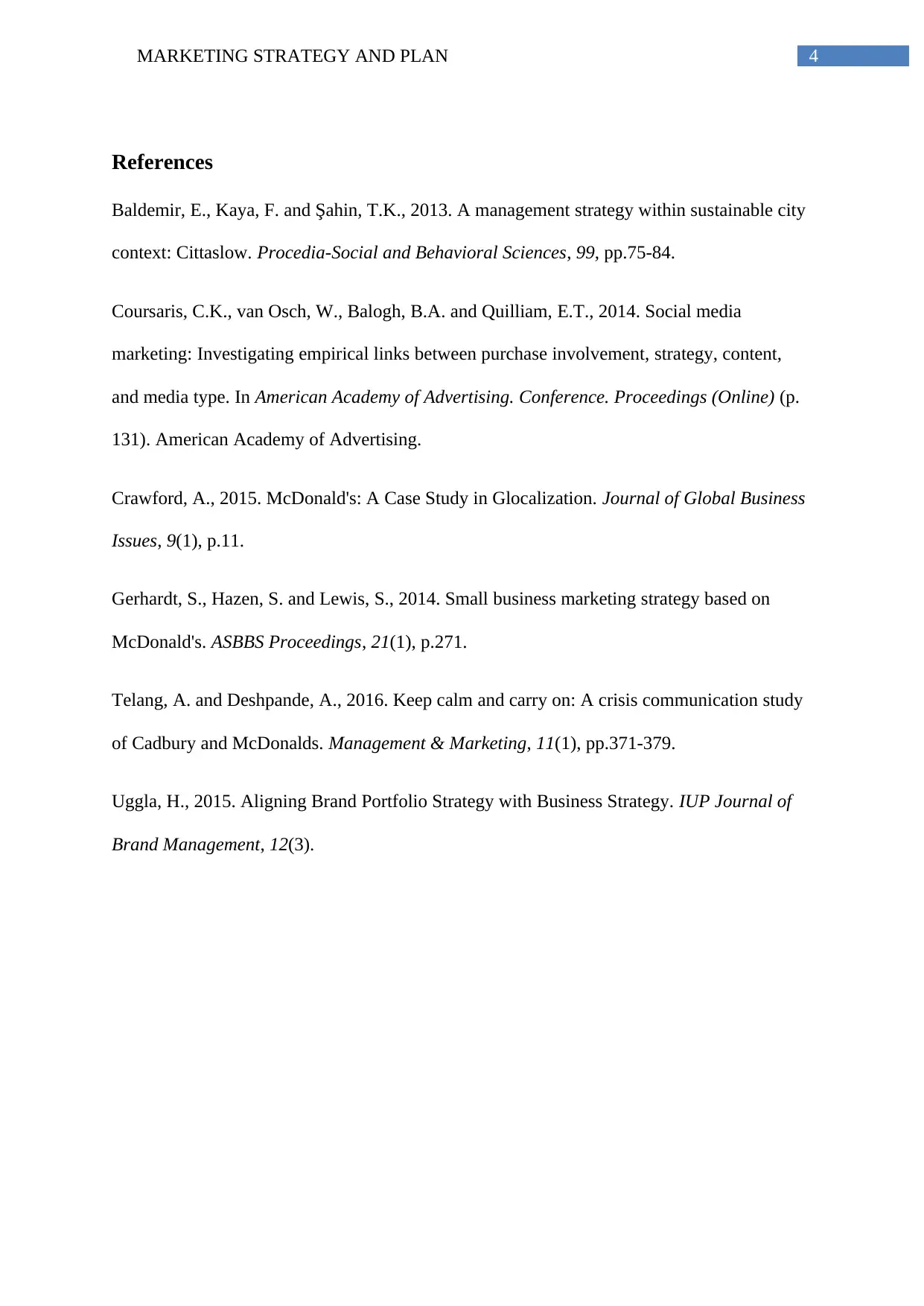
4MARKETING STRATEGY AND PLAN
References
Baldemir, E., Kaya, F. and Şahin, T.K., 2013. A management strategy within sustainable city
context: Cittaslow. Procedia-Social and Behavioral Sciences, 99, pp.75-84.
Coursaris, C.K., van Osch, W., Balogh, B.A. and Quilliam, E.T., 2014. Social media
marketing: Investigating empirical links between purchase involvement, strategy, content,
and media type. In American Academy of Advertising. Conference. Proceedings (Online) (p.
131). American Academy of Advertising.
Crawford, A., 2015. McDonald's: A Case Study in Glocalization. Journal of Global Business
Issues, 9(1), p.11.
Gerhardt, S., Hazen, S. and Lewis, S., 2014. Small business marketing strategy based on
McDonald's. ASBBS Proceedings, 21(1), p.271.
Telang, A. and Deshpande, A., 2016. Keep calm and carry on: A crisis communication study
of Cadbury and McDonalds. Management & Marketing, 11(1), pp.371-379.
Uggla, H., 2015. Aligning Brand Portfolio Strategy with Business Strategy. IUP Journal of
Brand Management, 12(3).
References
Baldemir, E., Kaya, F. and Şahin, T.K., 2013. A management strategy within sustainable city
context: Cittaslow. Procedia-Social and Behavioral Sciences, 99, pp.75-84.
Coursaris, C.K., van Osch, W., Balogh, B.A. and Quilliam, E.T., 2014. Social media
marketing: Investigating empirical links between purchase involvement, strategy, content,
and media type. In American Academy of Advertising. Conference. Proceedings (Online) (p.
131). American Academy of Advertising.
Crawford, A., 2015. McDonald's: A Case Study in Glocalization. Journal of Global Business
Issues, 9(1), p.11.
Gerhardt, S., Hazen, S. and Lewis, S., 2014. Small business marketing strategy based on
McDonald's. ASBBS Proceedings, 21(1), p.271.
Telang, A. and Deshpande, A., 2016. Keep calm and carry on: A crisis communication study
of Cadbury and McDonalds. Management & Marketing, 11(1), pp.371-379.
Uggla, H., 2015. Aligning Brand Portfolio Strategy with Business Strategy. IUP Journal of
Brand Management, 12(3).
1 out of 5
Related Documents
Your All-in-One AI-Powered Toolkit for Academic Success.
+13062052269
info@desklib.com
Available 24*7 on WhatsApp / Email
![[object Object]](/_next/static/media/star-bottom.7253800d.svg)
Unlock your academic potential
Copyright © 2020–2025 A2Z Services. All Rights Reserved. Developed and managed by ZUCOL.





